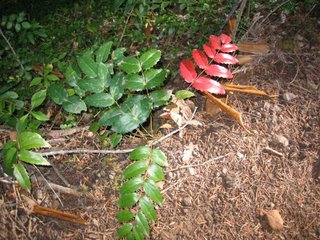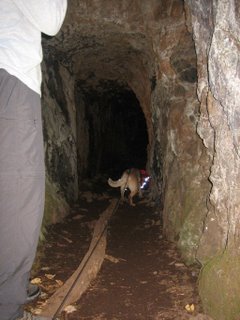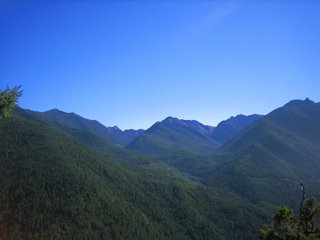It was another great day in the Pacific Northwest. Bright and sunny with clear, blue sky all around. Which was pleasantly surprising after the past week's icky weather. Seemed Mother Nature went to her closet to clean out the Summer clothes and bring in the Fall apparel. Gray, rainy and decidely cooler. Although somewhat cool in the morning, it was really perfect hiking weather, again. :-)
 Kiwi makes sure we observe National Forest policy and sign in at the registration point. She normaly gives me the three minute lecture on not disturbing nature, packing what you take in , back out with you, bear and cougar safety lessons and to make sure to always carry the safety essentials for hiking. Yes Ma'am, private Mike and Jordy (my son) ready to go ma'am. LOL
Kiwi makes sure we observe National Forest policy and sign in at the registration point. She normaly gives me the three minute lecture on not disturbing nature, packing what you take in , back out with you, bear and cougar safety lessons and to make sure to always carry the safety essentials for hiking. Yes Ma'am, private Mike and Jordy (my son) ready to go ma'am. LOL This little guy was the first thing to capture my eye. Definitely alluding to the fall change in the air.
This little guy was the first thing to capture my eye. Definitely alluding to the fall change in the air. What you won't see much in these pictures is that about eighty percent of the hike was rather dark. Even though the day was super, we were still in the mountain's shadow for the majority of our trail time. Here is somewhat of an opening to capture Kiwi. She went the whole hike with her RuffWear Palisade's II Backpack (empty).
What you won't see much in these pictures is that about eighty percent of the hike was rather dark. Even though the day was super, we were still in the mountain's shadow for the majority of our trail time. Here is somewhat of an opening to capture Kiwi. She went the whole hike with her RuffWear Palisade's II Backpack (empty). An early peak-a-boo view of the Buckhorn wilderness. Told ya it was an awesome day. :-)
An early peak-a-boo view of the Buckhorn wilderness. Told ya it was an awesome day. :-) The wilderness we were hiking in was part of an area that supported hopeful mining efforts in the early 1900's. Iron Mountain was supposed to be full of copper and manganese. The mine lasted on a few years, but what was left is an extensive network of wet shafts in the generally stable bedrock.
The wilderness we were hiking in was part of an area that supported hopeful mining efforts in the early 1900's. Iron Mountain was supposed to be full of copper and manganese. The mine lasted on a few years, but what was left is an extensive network of wet shafts in the generally stable bedrock. Below we encountered a water run-off pipe that was at least thirty minutes from the mine. Yes, very dark.
 Here is some of the old abandoned equipment that has been "recycled" by hikers and campers to support the good-tasting smores habit. :-)
Here is some of the old abandoned equipment that has been "recycled" by hikers and campers to support the good-tasting smores habit. :-) One of the shaft entrances that went nowhere. Fun to explore and tell spooky tales to my teenager. ROFL
One of the shaft entrances that went nowhere. Fun to explore and tell spooky tales to my teenager. ROFL He was game though. Went in by himself to spelunker. Worth a few good stories at school, no?
He was game though. Went in by himself to spelunker. Worth a few good stories at school, no? Then it was time to take the side trip to the crash site. A short, approximately half mile, but steep, hike to the site. No trouble for the four-legged hikers. Kiwi kept looking back at us, wondering why we kept stopping. I pretended to be adjusting my pack and Jordy would whistle and take pictures. Or was that his asthma. :-) But she had us march to the site in short order with her barking double-time at us. LOL
Then it was time to take the side trip to the crash site. A short, approximately half mile, but steep, hike to the site. No trouble for the four-legged hikers. Kiwi kept looking back at us, wondering why we kept stopping. I pretended to be adjusting my pack and Jordy would whistle and take pictures. Or was that his asthma. :-) But she had us march to the site in short order with her barking double-time at us. LOL The plane crash: In January of 1952, a rescue mission was dispatched to search for a ship in distress off the coast off Washington. Unable to locate the ship, the aircraft, a converted B-17, was attempting to return to Seattle. For one reason or another, the altimeter in the plane was off by more than 1500 feet. In a driving snow storm, unable to make out any land marks, and vectored too far south by the tower, the airplane flew right into the canyon slope, and ended up in a marsh at the canyon mouth. Over the years, the wreckage has been picked pretty clean by souvenir hunters, but major pieces still set where they have for over 50 years.
The plane crash: In January of 1952, a rescue mission was dispatched to search for a ship in distress off the coast off Washington. Unable to locate the ship, the aircraft, a converted B-17, was attempting to return to Seattle. For one reason or another, the altimeter in the plane was off by more than 1500 feet. In a driving snow storm, unable to make out any land marks, and vectored too far south by the tower, the airplane flew right into the canyon slope, and ended up in a marsh at the canyon mouth. Over the years, the wreckage has been picked pretty clean by souvenir hunters, but major pieces still set where they have for over 50 years.Last flight of 746
The following is the Accident Report Narrative from the official accident report. It was written by Captain Hybki for the board of inquiry.
The accident occurred at 1832 hours, PST, 19 Jan 1952. When the aircraft hit the top of the hill, I was thrown out on top. I could hear the aircraft still falling (going down the hill). I walked to the edge of the hill and waited there. At this time, I could hear nothing. I started down the hill towards what I thought was civilization. When I was 1/3 of the way down the hill, I stopped to rest and heard noises. I blew the whistle on my Mae West, I could now hear the others at the aircraft, and joined the rest of the party. The others searched for clothes, got a jacket and boots for me, put me in an exposure suit, and sleeping bag. I was shivering, but not from cold. I believe this was due to shock. Two hours later I fell asleep.
The rest of the party was removing equipment from the wreck and building a windbreak with the cutes. A life raft was used to make a floor in the shelter. The engineer (who was also injured) and I were bedded down. When I woke after dawn, I awakened the rest of the party. The engineer and I were removed from the sleeping bags and fitted with warm clothes, which were obtained from the crew's bags. Our wounds were now dressed. We could find no first aid kits from the airplane and had to use the ones from the rescue kits. The only dressings available were compresses, which were very bulky hard to put on and harder to use when applied. Some Band-Aids would have been very useful.
The three who were not seriously injured began gathering dry wood, pine needles and inflammable parts from the wreck to use in the fires. Dry wood and pine needles are fine for building fires and the rubberized materials from the plane are excellent for making smoke. Fire was provided by matches that the crew had and from matches that were found in the emergency kits. We now started a fire. Every kit was broken open and flares and smoke bombs were removed. The abundance of kits was a big morale booster. The boat, with supplies, was never found. Red and orange chutes, all our yellow equipment, sea marker die, and a streamer were put out.
Aircraft were heard overhead but they passed over. I suppose that they were going to previously assigned search areas. When aircraft were heard, we sent SGT Farmer to the top of the hill to shoot flares. About 80% of the flares functioned properly. Only 1 out of 3 of the smoke flares worked. It was very difficult to get the tops off the smoke flares. It is almost impossible to do with gloves or mittens on and with cold bare hands it is very difficult. Some method should be devised so that one's teeth could be used.
Finally about 1000 hours a C-46 spotted the party and a few moments later, many aircraft came over the area. I believe a URC4 transmitter was dropped. Food was now broken out using first the tins with candy. We only ate one candy bar apiece, however, because we thought that the candy might make us sick. This food was edible and in good condition. The IF4s were opened and the food was frozen in them. Sterno was used to heat the food but was very ineffective because the flame would go out in the slightest breeze. We all think that cook cans would be much more satisfactory. This is the kind that heats the food by letting air into an outer casing. SGT Scargall tried to make some coffee but due to using snow and having difficulty with the sterno pots, the coffee was no good. The water jugs on the plane could never be found. No attempt was made to look for the three others because no one was in good enough shape to conduct the search. At this time the helicopter came and took us away.
The following pictures were taken today, 23 Sept 2006.




 Wow, some history on this hike, huh?
Wow, some history on this hike, huh?Here is a shot up the canyon, looking above the crash site, again high-lighting the beautiful autumn day.
 On our way back, Kiwi stops for a photo-op at a small waterfall. :-) Not the greatest hike for majestic scenery, but still relatively easy and fun none the less. (thumbs up)
On our way back, Kiwi stops for a photo-op at a small waterfall. :-) Not the greatest hike for majestic scenery, but still relatively easy and fun none the less. (thumbs up) Another view of the magnificent Buckhorn Wilderness on our drive out.
Another view of the magnificent Buckhorn Wilderness on our drive out.
The day's video

2 comments:
Hola ACDL,
Thank you very much for posting your comments. It's great to get feedback and interact with other ACD owners.
The audio track contained more selections from the Buddha Bar series. Let me know how you what you think when your CD's arrive.
This hike was geared with my son in mind. Majestic scenery is not appreciated by teens as much as us older teens. ;-) Hence the sites and activites to explore. As long as I get a couple of "cools" I consider it successful. LOL
You have a good eye on noticing Kiwi barking at the tiny waterfall. I believe she is like most ACD's (furry tumors) in that she has to be close to her pack. She has bonded the strongest with me and if I get near the edge of her leash perimeter and she can't join me, she lets her feelings be known. Even when other family members are with her. If I go into a building and leave her parked outside where she can't see me, she will bark just a few times and then patiently wait for my return.
Ah yes, the "roads". This one was about thirteen miles of dirt, rocks, dust, and pot-holes, along side mountains with steep drop-offs. I have yet to get drowsy driving these types. LOL My desire is to eventually get a Jeep or old Toyota Land Cruiser for the wilderness transportation needs. All the mountain roads don't help the resell value of the Ferrari. :-)
Take care and peace.
R/ Mike
Great to hear from you Kelly. I adjusted the blog settings so it shouldn't take as long to download now. Also I'm trying to put the videos IN the blog, so viewers don't have to leave the site. Although not too successfully. :-( I'll keep at it.
They say it takes a village to raise someone and I think that applies to Kiwi. I have read quite a bit on dogs, subcribe to the ACD List for its plethora of breed specific information, listen to our instructors and other knowledgeable folk and its still a challenge. Continuously learning. Maybe if I hadn't have been the vilage idiot it would be easier. LOL
Oh oh, the sticker. Uh, well,....the Porshe was in for a tune-up. Yes, that its. The sticker is on the Ferrari this week. :-)
And a big thanks for your personal time to check on Kiwi last night. We appreciate it.
R/ Mike
Post a Comment